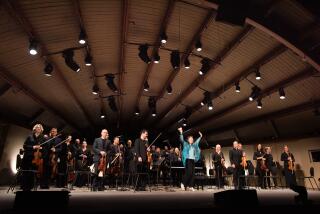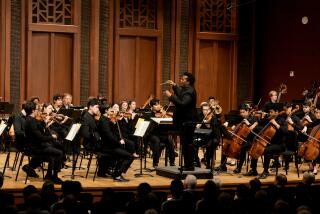Expressive Ease Marks Williams’ Concert
- Share via
Fleet fingers and adventuresome spirits abound in the guitar world today, and the lineage of the accomplished and eclectic postmodern guitarist descends from John Williams. Friday, the Australian master returned for a wide-ranging and joyful survey of instrumental songs and dances at the Dorothy Chandler Pavilion.
Carlo Domeniconi’s Turkish-inspired “Koyunbaba” uncoils obsessively from a unique tuning, challenging not only technique but also sustainable imagination. Williams kept it magically alive, brooding in power and mystery.
Phillip Houghton’s “Stele” is a four-movement suite suggested by Greek art. Its pictorialism, however, is abstract and allusive, though never arid. It does convey a sense of distance in time and space, a perspective then reversed by three of Mikos Theodorakis’ “Epitafios,” direct and immediate song arrangements.
Williams played both groups with expressive ease. He worked gracefully across a broad timbral and dynamic range, although both color and clarity were often compromised by unflattering amplification; the arrangement Friday sacrificed warmth and naturalness to volume and presence.
To open, there were the Baroque dances of Bach’s Fourth Lute Suite. Once past the perpetual whirl of the Prelude, Williams treated these dances with lyrical freedom, retaining kinetic accents while allowing a caressive curl to the lines.
The “Medieval Suite” that Williams has compiled and arranged from several sources is a loose exercise in melodic characterization. The tunes are strong, the settings spare, and the playing fluid. Much the same could be said about his transcription of two Albeniz favorites, “Mallorca” and “Cordoba.”
In encore, Williams turned to the infectious West African rhythms of singer-guitarist Francis Bebe with “The Magic Box” and “Makassa,” both understated yet zesty, and elegantly sprung.
More to Read
The biggest entertainment stories
Get our big stories about Hollywood, film, television, music, arts, culture and more right in your inbox as soon as they publish.
You may occasionally receive promotional content from the Los Angeles Times.










